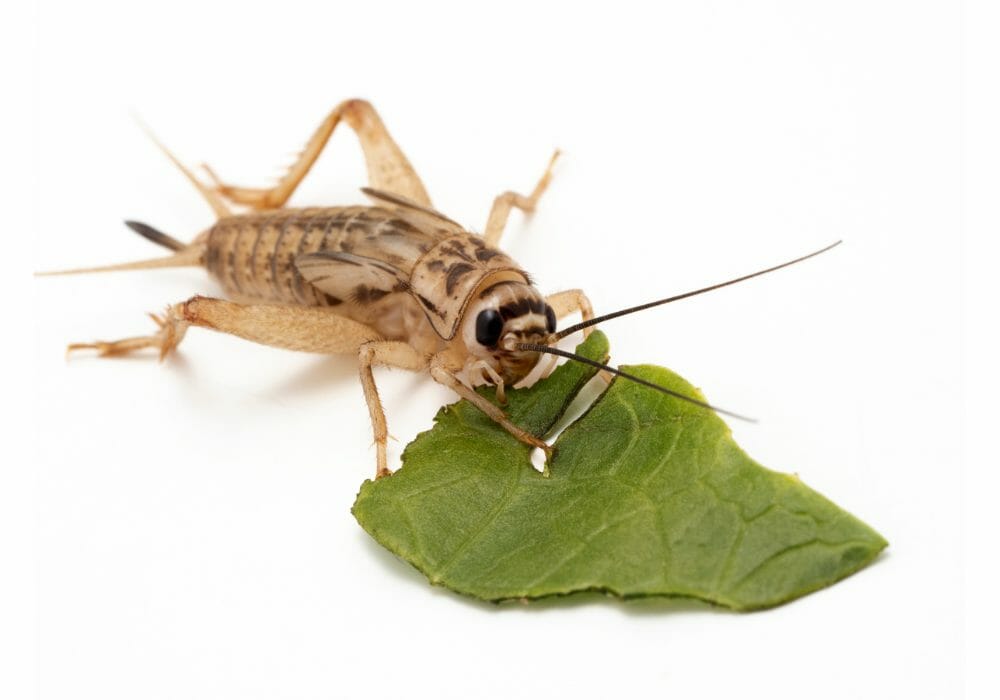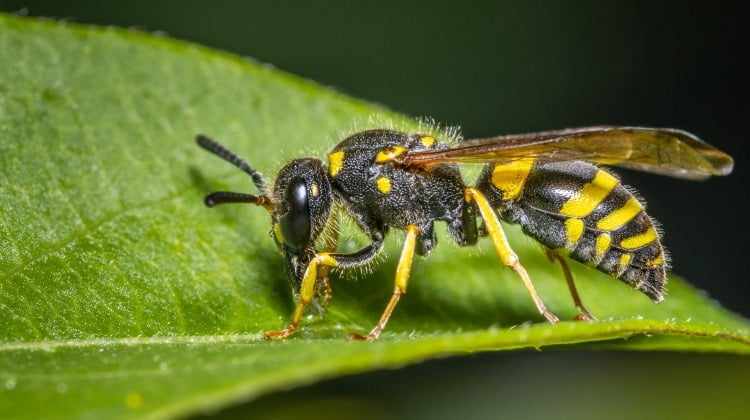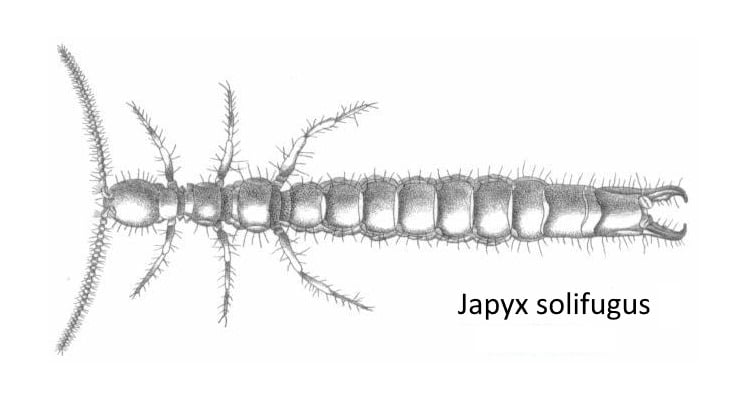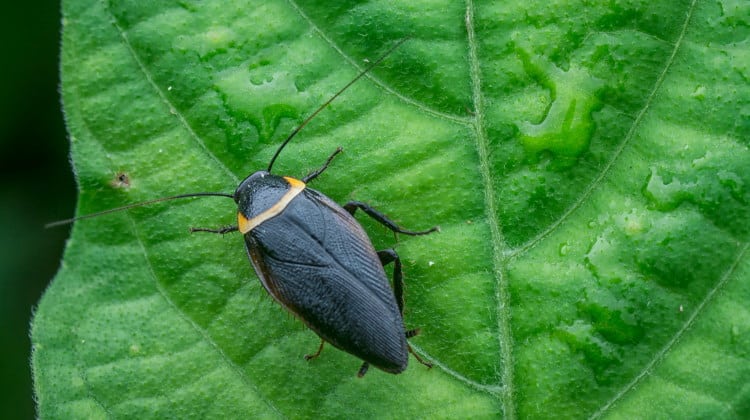What Do Crickets Eat & What To Feed Them
[modified-date]
[social-share]
Crickets are fascinating critters that belong to the insect order Orthoptera together with grasshoppers and locusts.
Beyond their unbound life in the wild, they are popular to raise in captivity for reasons not very appealing to crickets themselves – to serve as fish bait, live food for pets, or even for human consumption. Luckier among the captive house crickets are the crickets kept as pets in China and Japan.
Like all living things, crickets need to eat to survive, even when they’re meant to become food themselves (sorry, chirpy buddies). Let’s discover the secrets of the cricket diet – what do crickets eat naturally, as well as the best way to feed them in captivity.
What Do Crickets Eat?
Crickets are omnivores, meaning they eat both plant and animal matter. In nature, they eat various foods: fruits, vegetables, foliage, flowers, insect larvae, and other defenseless insects, dead invertebrates, or other scavenged meat. In captivity, they are highly adaptable and can eat a variety of foodstuffs, including commercial pet food.
More About Crickets
There are many species of crickets, but the most famous and most commonly raised one is the house cricket, Acheta domesticus.

Drab in color, these orthopterans are interesting in many other ways – known for their lively chirping and jumping abilities like camel crickets. They can also give a decent bite and are escape artists, which is important to know if you’re planning on keeping them in captivity.
House crickets are native to Asia. However, they have become widespread due to the mass production that began in the 1950s. But who in the world thought of cricket farming?
It turns out that the idea is not so novel since crickets have been a part of the traditional menus in Asia for centuries. For an equally long time, and in China predominantly, house crickets have been praised pet cricket, loved for their “vocal” abilities, but also the male cricket fighting skills.
Due to the nutritional content (especially protein), the ease of reproduction, and other favorable factors, house crickets have become food source insect or protein feed for domestic animals and reptile pets. In the second decade of the 20th century, they have been officially approved for use in the human food industry in Europe.
Did you Know?
In the first decade of the 21st century, almost the entire captive population of house crickets was decimated due to the cricket paralysis virus. Since then, the Jamaican Field Cricket (Gryllus assimilis) has been introduced into the market as a resilient alternative.
These are all the reasons why crickets have become widely farmed. Raising an organism in captivity, even if it is a non-picky insect, always propels the need to find out as much as possible about its diet. And that is not crucial for insects only – the nutritional value of feeder crickets largely depends on the foodstuffs they’ve been consuming.
What Do Crickets Eat In The Wild?
To understand how to provide a good diet for crickets in captivity, we should first look at what they eat in the wild.
Plants

Unlike the related grasshoppers, who are often satisfied with something tough as grass blades, adult crickets like juicy, tasty, and highly nutritious plant parts. These include fresh fruit, vegetables, seeds, and flowers. The other popular cricket species, Jamaican Field Cricket (Gryllus assimilis), also readily eats seedlings.
Other Insects
House cricket’s carnivory usually manifests as eating other insects. Crickets will eat all insects that are smaller and defenseless – larvae, pupa, aphids, and hurt or dead adults of various species (including other crickets). Again, the Jamaican Field Cricket has a specific preference – fly pupa.
Scavenged Meat
Most crickets out there will take a nibble if they come across a favorable and easily accessible piece of meat, such as dead fish.
Did you know? Box:
Did you Know?
The so-called ant loving-crickets of the genus Myrmecophilus are tiny, wingless, ,they can’t chirp as they are soundless crickets that live in ant nests and eat the food that ants collect. What a sequel to The Ant & The Cricket story!
Cricket Diet In Captivity

Feeding crickets the best possible food also helps animals that consume them gain as many nutrients as possible. Crickets have voracious appetites, meaning that they will make their guts full wherever they get a chance.
That makes crickets the perfect feeder insects – because they can be gut loaded easily before feeding to your pets.
Gut loading is the process when you feed the feeder insects a nutrient-dense and high-vitamin diet before feeding them to your pets. That way, the pet animals consume the content of the cricket’s guts along with the cricket itself.
Luckily, crickets are not picky at all – and will eat pretty much anything high in protein and plant sugar offered to them.
Here is a list of easily available and nutrient-packed cricket foods.
- Vegetables. Carrots, Squash, Potato, Sweet Potato, Spinach, Kale, and other leafy greens are all safe bets for crickets and will provide plenty of nutrients without exposure to harmful compounds.
- Fruits: Apples, pears, bananas, oranges, melons. You can include other, more watery fruits as well, but these are the most practical.
- Grains. Wheat germs, rice meal, rolled oats, and alfalfa – all good choices.
- “Meat” (protein sources). Providing crickets with raw meat is a sanitary risk, so opt for commercial pet foods – dry dog and cat food, fish flakes, and suitable reptile foods.
Commercial cricket food are also available and provide the right balance of nutrients in one meal, as well as supplements to add protein if you’re keeping your crickets on a plant material diet only.
Should I Give Water To My Crickets?
Although they can get a certain percentage of water from fruits and veggies, crickets need a source of clean water available at all times. Otherwise, they can die of dehydration.
Because crickets are not good swimmers and are not particularly strong or big either, they can easily drown in a plain water tray.
Because of that, you can provide water in the form of a soaked cotton ball. If you would still prefer a water tray, make sure it’s really small (like a bottle cap), really shallow, or filled with pebbles or marbles so crickets can walk on the surface.

Tips For Feeding Crickets
Here are several tips for trouble-free cricket feeding in captivity.
- Crickets know how much food they need, so the amount of food per meal is not crucial; you don’t have to measure anything.
- The shape of the food is also not important – crickets can consume literally entire fruits or vegetables. However, I recommend serving the food in (physically) separated pieces as there is less chance of food getting moldy.
- You can serve grains and pet food in lids or other shallow dishes.
- Keep the dry food separate from moist food and water.
- Check on the food every other day.
- Remove the pieces that have gone moldy or too rotten – the sooner, the better.
- Crickets are known to smell a bit; by keeping their tank clean, you are helping this be less of a problem.
Conclusion
Hopefully, you are now familiar with what crickets eat. They are omnivores with large appetites and are not very choosy. Thus, their nutritive needs are not difficult to meet.
Still, the variety of food, the feeding-related hygiene, and providing a water source are all important when feeding the crickets in captivity. By feeding the feeder insects right, you are helping your pets as well.
Resources
- Active and Covert Infections of Cricket Iridovirus and Acheta domesticus Densovirus in Reared Gryllodes sigillatus Crickets. Front. Microbiol., Sec. Microbial Symbioses, 30 November 2021
- Best Feed or Gut Load for Crickets. Spruce Pets. 2 August 2022.
- Orthoptera: grasshoppers and locusts. Insects and Their Allies. CSIRO.
- Raising Crickets For Fish Bait by James T. Davis (PDF). Texas A&M University
- What Do Crickets Eat? Bioexplorer. 16 October 2022
- What to Feed Crickets. WebMD Fetch. 7 July 2021

Katarina Samurovic is an environmental analyst by education and a freelance scientific writer by choice and passion. She specializes in conservation biology, biodiversity, insect ecology, and trees.
Disclaimer
Earthlife.net does not provide medical advice. We do our best to help users understand the science behind living beings; however, the content in the articles and on the website is not intended to substitute for consultation with a qualified expert. By interacting with the website and/or our email service, you agree to our disclaimer. Remember that you must consult a specialist before using any of the products or advice on the web.




